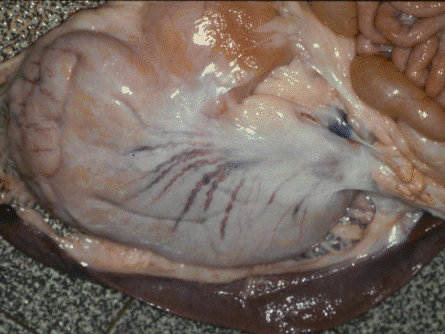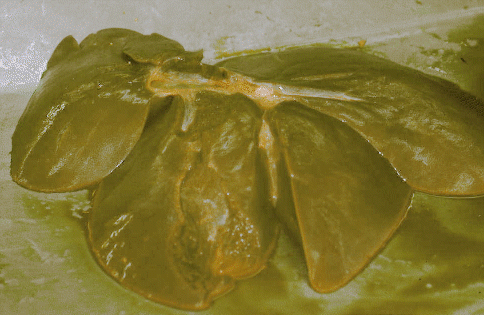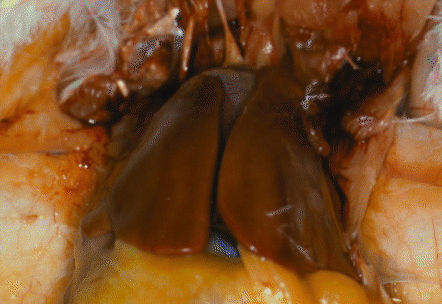 This is the stomach of a pig on the floor of our abattoir, with some of the small intestines showing in the top right corner.
This is the stomach of a pig on the floor of our abattoir, with some of the small intestines showing in the top right corner.
 This is the stomach of a pig on the floor of our abattoir, with some of the small intestines showing in the top right corner.
This is the stomach of a pig on the floor of our abattoir, with some of the small intestines showing in the top right corner.
In cattle and sheep, instead of opening directly into a glandular stomach where digestion begins , the esophagus leads to a series of three extra compartments, the rumen, the reticulum and the omasum. These compartments are lined with stratified squamous epithelium.
In young lambs and calves that are still drinking milk, the rumen and reticulum may be by-passed. The presence of the milk is detected by sensory nerve endings in the mouth and pharynx. Reflex activity brings heavy muscular folds in the walls of the rumen and reticulum together forming an esophageal groove that leads directly from the cardia to the omasum.
The rumen or paunch is a very large muscular bag on the LEFT side of the body, extending from the diaphragm back to the pelvis.
The smooth muscle of the rumen wall consists of two layers; a superficial layer from anterior to posterior, and an inner layer running transversely to form muscular pillars.
The reticulum is lined by thin, wall-like ridges arranged in a honeycomb pattern. The reticulum is posterior to the heart and diaphragm (Figure 1-3).
The rumen and reticulum contain countless microorganisms whose metabolic activity greatly enhances the nutritive value of typical ruminant feed.
The omasum is almost spherical in shape and is filled with muscular plates hanging from the dorsal roof. These plates or laminae are studded with short, blunt papillae whose function is to grind roughage. The trade name of the omasum is the manyplies or book-bag.
The true glandular stomach or abomasum is located ventrally to the omasum (Figure 1-4). The epithelium of the abomasum is glandular with many mucus cells.
In a typical lean beef steer, the emptied weight of the rumen, reticulum, omasum and abomasum comprises about 2.5% of the live weight.
The growth of the rumen and reticulum in calves is very rapid but the abomasum grows more slowly
The gut fill is extremely variable, but is often around 15% of the live weight.
A number of different types of animals have the ability to digest cellulose with the help of symbiotic bacteria and ciliates in modified parts of the alimentary canal, but the ruminant system has a number of superior features that account for its great efficiency. Chewing the cud (the repeated regurgition and mastication of feed) would not be possible unless the main fermentation chamber, the rumen, was situated before the true stomach or abomasum. Thus, ruminants are able to achieve a very high efficiency of feed grinding, unlike the horse in whose feces may be seen quite large particles of intact plant material. Another advantage of the ruminant system is that a long length of intestine is available for absorption after the point at which fermentation occurs.
Rumen microorganisms themselves are very effective - they synthesize protein from low-grade nitrogenous materials such as ammonium salts and urea added to the feed. Equally important, they utilize sulfate to produce the essential amino acids cysteine and methionine, and they also synthesize B group vitamins, particularly vitamin B12. Rumen microorganisms obtain their own energy anaerobically with only a relatively low energy yield. Thus, the ruminant is able to take the residual energy from products of fermentation such as acetic, propionic, and butyric acids. The acidity of these substances is buffered by sodium bicarbonate from the saliva.
 This shows how, in poultry, the stomach is divided into two chambers (Figure 1-5). As is often the case, there is a fair amount of fat or adipose tissue covering both chambers. The first chamber, the proventriculus or glandular stomach seen on the left in the color frame, secretes pepsin and hydrochloric acid. The second chamber, the gizzard seen on the right in the color frame, is thick and muscular with a horny internal epithelium and a high collagen content (Gabella, 1985). In the color frame, the collagen can be seen as a blue sheen, radiating across the gizzard. The gizzard grinds the feed and mixes it with the enzyme mixture from the proventriculus. This is the reverse of the sequence found in the omasum and abomasum of ruminants where grinding of the feed takes place before it is exposed to the enzymes from the true stomach.
This shows how, in poultry, the stomach is divided into two chambers (Figure 1-5). As is often the case, there is a fair amount of fat or adipose tissue covering both chambers. The first chamber, the proventriculus or glandular stomach seen on the left in the color frame, secretes pepsin and hydrochloric acid. The second chamber, the gizzard seen on the right in the color frame, is thick and muscular with a horny internal epithelium and a high collagen content (Gabella, 1985). In the color frame, the collagen can be seen as a blue sheen, radiating across the gizzard. The gizzard grinds the feed and mixes it with the enzyme mixture from the proventriculus. This is the reverse of the sequence found in the omasum and abomasum of ruminants where grinding of the feed takes place before it is exposed to the enzymes from the true stomach.
 No mistaking this lot - a pile of small intestines from the pig. In beef animals, slightly over 2% of the live weight is from the emptied weight of the intestines. The small intestine is composed of three regions, the duodenum, the jejunum and the ileum. The duodenum receives the hepatic and pancreatic ducts and has a complex glandular structure.
No mistaking this lot - a pile of small intestines from the pig. In beef animals, slightly over 2% of the live weight is from the emptied weight of the intestines. The small intestine is composed of three regions, the duodenum, the jejunum and the ileum. The duodenum receives the hepatic and pancreatic ducts and has a complex glandular structure.

This is the caecum of a pig.
The colon is divided into ascending, transverse and descending parts, and it terminates at the rectum and anus. Poultry have two caeca (Figure 1-5) just before the rectum. In poultry, but not in cattle, sheep or pigs, the inner surface area of the large intestine is expanded by villi.
In poultry, the equivalent aperture to the anus is part of a compound structure called the cloaca. The cloaca is divided into three regions but these are difficult to distinguish. The rectum enters the cloaca at the coprodeum, the urinary and genital ducts enter at the urodeum and the opening to the exterior is called the proctodeum. Dorsal to the proctodeum is a region of lymphoidal tissue called the bursa of Fabricius.
Some parts of the alimentary canal have a considerable commercial value as natural casings. After extensive cleaning and preparation, they are used as natural casings to contain different types of sausages and processed meat products.
The teeth of meat animals have a complex structure. Briefly, dental formulae may be used to describe the patterns of teeth in meat animals. The four types of teeth are indicated by a letter notation;
The numerator and denominator of a fraction are used to indicate upper and lower numbers of teeth, respectively.
Left and right sides of the jaws are not written separately but are indicated by the initial factor, x2.
A prefix, D, is used to denote deciduous teeth that are present in the young animal but replaced in the older animal.
Calf and lamb = 2 x (DI 0/4, DC 0/0, DP 3/3)
Mature cattle and sheep = 2 x (I 0/4, C 0/0, P 3/3, M 3/3)
Young pig = 2 x (DI 3/3, DC 1/1, DP 4/4)
Mature pig = 2 x (I 3/3, C 1/1, P 4/4, M 3/3)
The transition from deciduous to permanent dentition follows a rather complex pattern between 1.5 to 4 years in cattle, 0.25 to 4 years in sheep, and 8 to 20 months in pigs. Most commercially reared meat animals will, therefore, be at an intermediate stage between deciduous and permanent dentition when slaughtered.
The salivary glands of ruminants are extremely productive since they must produce much of the fluid with which the feed is mixed to form a slurry. The salivary glands of a steer, for example, might secrete well over 100 liters of saliva per day.
 As you may be able to see in this pig liver, the pig has four equally large lobes plus a small caudate lobe on the right side. Apart from a small caudate lobe on the right side, the bovine liver is not subdivided into lobes. The liver in sheep is similar to that in the bovine, but there is something of a fissure in the main lobe.
As you may be able to see in this pig liver, the pig has four equally large lobes plus a small caudate lobe on the right side. Apart from a small caudate lobe on the right side, the bovine liver is not subdivided into lobes. The liver in sheep is similar to that in the bovine, but there is something of a fissure in the main lobe.
The function of the liver is to store carbohydrate, process nutrient-rich incoming blood from the gut, and produce bile.
Livers are condemned if they are infected by trematode flukes such as Fasciola hepatica in ruminants, or by nematodes such as Ascaris suum in pigs.

Here is the liver of a hen, with yellow yolks of eggs being formed at the bottom of the window.
The pancreas is a pale yellow gland located between the stomach and the small intestine in mammals, and in a loop of the duodenum in poultry. It has one or two ducts that convey pancreatic juice to the duodenum.